HI6006 Competitive Strategy: Exploring Key Strategy Development Tools
VerifiedAdded on 2022/10/04
|8
|1734
|27
Essay
AI Summary
This essay provides a comprehensive analysis of three key strategy development tools: PESTEL, SWOT, and Ansoff Matrix, with a practical application to the telecommunications company Telstra. The essay begins with an introduction that highlights the increasing importance of strategic tools in today's competitive landscape, driven by globalization, technological advancements, and intense market competition. The PESTEL analysis examines the external macro-environmental factors influencing Telstra, including political, economic, social, technological, legal, and environmental aspects. The SWOT analysis evaluates Telstra's internal strengths and weaknesses, along with external opportunities and threats. The Ansoff Matrix explores potential growth strategies for Telstra, including market penetration, product development, market development, and diversification. The essay concludes by emphasizing the vital role of strategy development tools in ensuring a business's sustainability and growth, summarizing how Telstra can leverage these tools to capitalize on market opportunities and navigate the challenges within the telecommunications industry.

Running Head: STRATEGIC MANAGEMENT 0
STRATEGY DEVELOPMENT
MODELS
STRATEGY DEVELOPMENT
MODELS
Paraphrase This Document
Need a fresh take? Get an instant paraphrase of this document with our AI Paraphraser

STRATEGIC MANAGEMENT 1
Contents
Introduction..............................................................................................................................2
Pestle Model..............................................................................................................................2
Swot Model...............................................................................................................................4
Ansoff Matrix...........................................................................................................................5
Conclusion.................................................................................................................................6
References.................................................................................................................................7
Contents
Introduction..............................................................................................................................2
Pestle Model..............................................................................................................................2
Swot Model...............................................................................................................................4
Ansoff Matrix...........................................................................................................................5
Conclusion.................................................................................................................................6
References.................................................................................................................................7
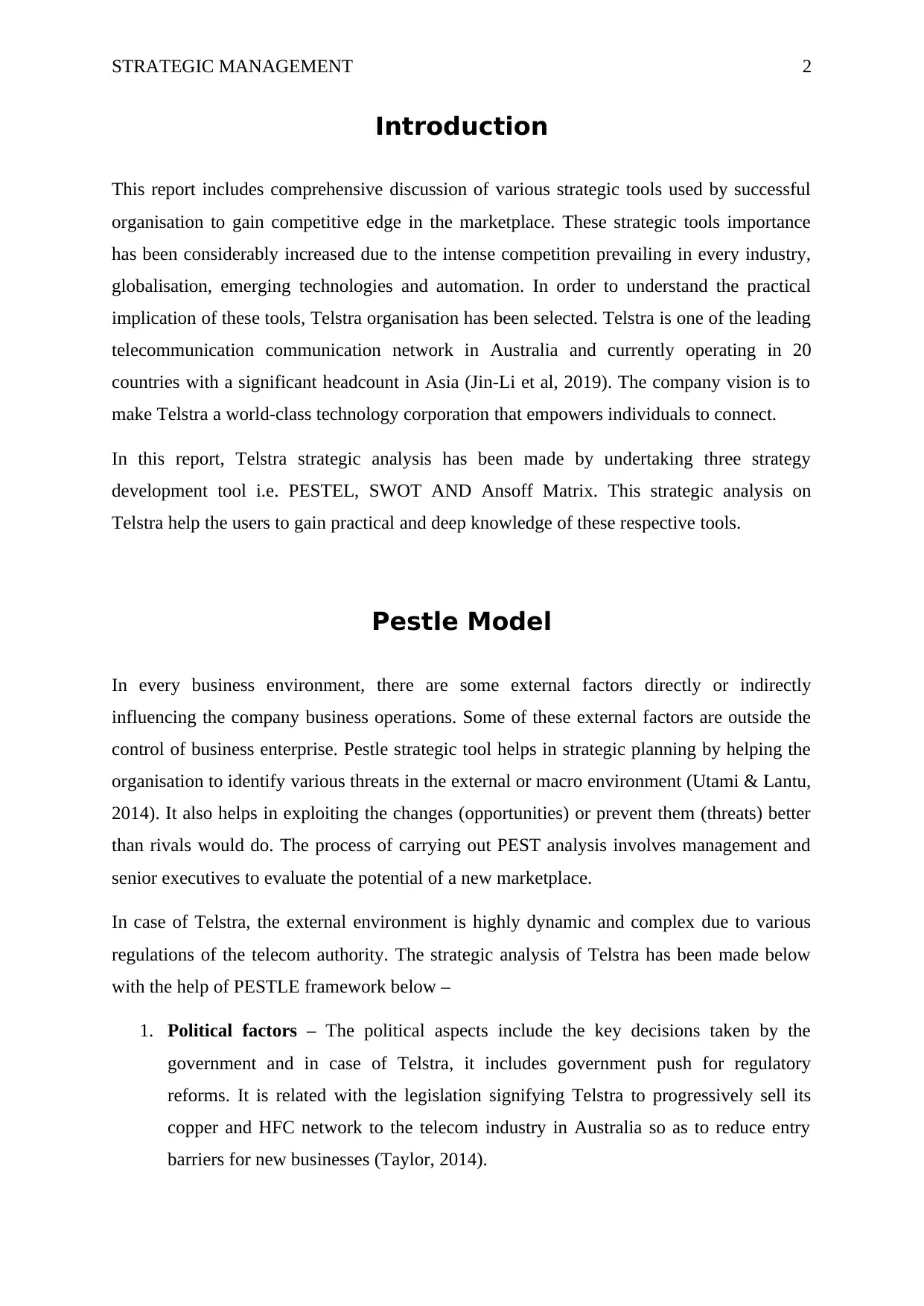
STRATEGIC MANAGEMENT 2
Introduction
This report includes comprehensive discussion of various strategic tools used by successful
organisation to gain competitive edge in the marketplace. These strategic tools importance
has been considerably increased due to the intense competition prevailing in every industry,
globalisation, emerging technologies and automation. In order to understand the practical
implication of these tools, Telstra organisation has been selected. Telstra is one of the leading
telecommunication communication network in Australia and currently operating in 20
countries with a significant headcount in Asia (Jin-Li et al, 2019). The company vision is to
make Telstra a world-class technology corporation that empowers individuals to connect.
In this report, Telstra strategic analysis has been made by undertaking three strategy
development tool i.e. PESTEL, SWOT AND Ansoff Matrix. This strategic analysis on
Telstra help the users to gain practical and deep knowledge of these respective tools.
Pestle Model
In every business environment, there are some external factors directly or indirectly
influencing the company business operations. Some of these external factors are outside the
control of business enterprise. Pestle strategic tool helps in strategic planning by helping the
organisation to identify various threats in the external or macro environment (Utami & Lantu,
2014). It also helps in exploiting the changes (opportunities) or prevent them (threats) better
than rivals would do. The process of carrying out PEST analysis involves management and
senior executives to evaluate the potential of a new marketplace.
In case of Telstra, the external environment is highly dynamic and complex due to various
regulations of the telecom authority. The strategic analysis of Telstra has been made below
with the help of PESTLE framework below –
1. Political factors – The political aspects include the key decisions taken by the
government and in case of Telstra, it includes government push for regulatory
reforms. It is related with the legislation signifying Telstra to progressively sell its
copper and HFC network to the telecom industry in Australia so as to reduce entry
barriers for new businesses (Taylor, 2014).
Introduction
This report includes comprehensive discussion of various strategic tools used by successful
organisation to gain competitive edge in the marketplace. These strategic tools importance
has been considerably increased due to the intense competition prevailing in every industry,
globalisation, emerging technologies and automation. In order to understand the practical
implication of these tools, Telstra organisation has been selected. Telstra is one of the leading
telecommunication communication network in Australia and currently operating in 20
countries with a significant headcount in Asia (Jin-Li et al, 2019). The company vision is to
make Telstra a world-class technology corporation that empowers individuals to connect.
In this report, Telstra strategic analysis has been made by undertaking three strategy
development tool i.e. PESTEL, SWOT AND Ansoff Matrix. This strategic analysis on
Telstra help the users to gain practical and deep knowledge of these respective tools.
Pestle Model
In every business environment, there are some external factors directly or indirectly
influencing the company business operations. Some of these external factors are outside the
control of business enterprise. Pestle strategic tool helps in strategic planning by helping the
organisation to identify various threats in the external or macro environment (Utami & Lantu,
2014). It also helps in exploiting the changes (opportunities) or prevent them (threats) better
than rivals would do. The process of carrying out PEST analysis involves management and
senior executives to evaluate the potential of a new marketplace.
In case of Telstra, the external environment is highly dynamic and complex due to various
regulations of the telecom authority. The strategic analysis of Telstra has been made below
with the help of PESTLE framework below –
1. Political factors – The political aspects include the key decisions taken by the
government and in case of Telstra, it includes government push for regulatory
reforms. It is related with the legislation signifying Telstra to progressively sell its
copper and HFC network to the telecom industry in Australia so as to reduce entry
barriers for new businesses (Taylor, 2014).
⊘ This is a preview!⊘
Do you want full access?
Subscribe today to unlock all pages.

Trusted by 1+ million students worldwide
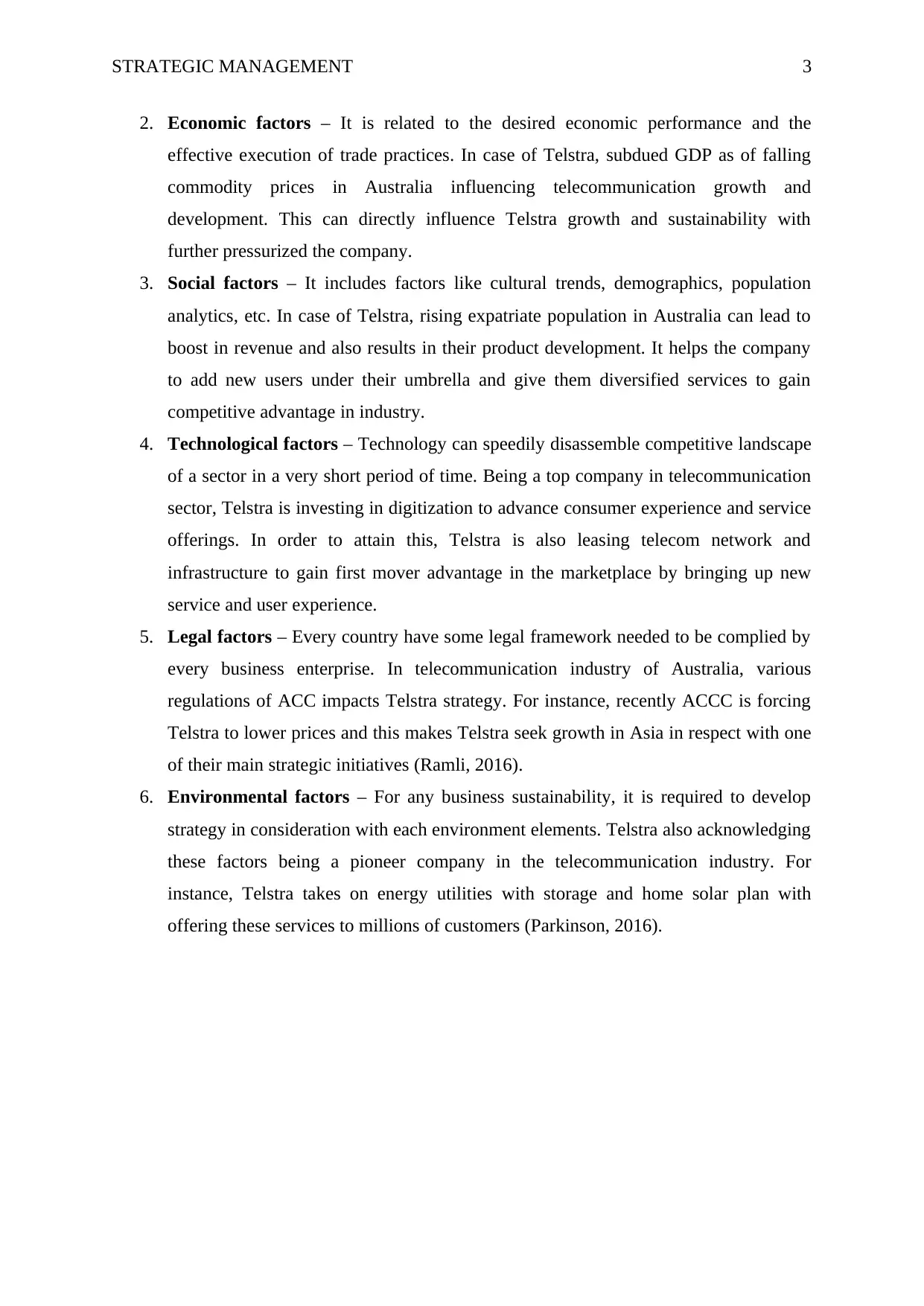
STRATEGIC MANAGEMENT 3
2. Economic factors – It is related to the desired economic performance and the
effective execution of trade practices. In case of Telstra, subdued GDP as of falling
commodity prices in Australia influencing telecommunication growth and
development. This can directly influence Telstra growth and sustainability with
further pressurized the company.
3. Social factors – It includes factors like cultural trends, demographics, population
analytics, etc. In case of Telstra, rising expatriate population in Australia can lead to
boost in revenue and also results in their product development. It helps the company
to add new users under their umbrella and give them diversified services to gain
competitive advantage in industry.
4. Technological factors – Technology can speedily disassemble competitive landscape
of a sector in a very short period of time. Being a top company in telecommunication
sector, Telstra is investing in digitization to advance consumer experience and service
offerings. In order to attain this, Telstra is also leasing telecom network and
infrastructure to gain first mover advantage in the marketplace by bringing up new
service and user experience.
5. Legal factors – Every country have some legal framework needed to be complied by
every business enterprise. In telecommunication industry of Australia, various
regulations of ACC impacts Telstra strategy. For instance, recently ACCC is forcing
Telstra to lower prices and this makes Telstra seek growth in Asia in respect with one
of their main strategic initiatives (Ramli, 2016).
6. Environmental factors – For any business sustainability, it is required to develop
strategy in consideration with each environment elements. Telstra also acknowledging
these factors being a pioneer company in the telecommunication industry. For
instance, Telstra takes on energy utilities with storage and home solar plan with
offering these services to millions of customers (Parkinson, 2016).
2. Economic factors – It is related to the desired economic performance and the
effective execution of trade practices. In case of Telstra, subdued GDP as of falling
commodity prices in Australia influencing telecommunication growth and
development. This can directly influence Telstra growth and sustainability with
further pressurized the company.
3. Social factors – It includes factors like cultural trends, demographics, population
analytics, etc. In case of Telstra, rising expatriate population in Australia can lead to
boost in revenue and also results in their product development. It helps the company
to add new users under their umbrella and give them diversified services to gain
competitive advantage in industry.
4. Technological factors – Technology can speedily disassemble competitive landscape
of a sector in a very short period of time. Being a top company in telecommunication
sector, Telstra is investing in digitization to advance consumer experience and service
offerings. In order to attain this, Telstra is also leasing telecom network and
infrastructure to gain first mover advantage in the marketplace by bringing up new
service and user experience.
5. Legal factors – Every country have some legal framework needed to be complied by
every business enterprise. In telecommunication industry of Australia, various
regulations of ACC impacts Telstra strategy. For instance, recently ACCC is forcing
Telstra to lower prices and this makes Telstra seek growth in Asia in respect with one
of their main strategic initiatives (Ramli, 2016).
6. Environmental factors – For any business sustainability, it is required to develop
strategy in consideration with each environment elements. Telstra also acknowledging
these factors being a pioneer company in the telecommunication industry. For
instance, Telstra takes on energy utilities with storage and home solar plan with
offering these services to millions of customers (Parkinson, 2016).
Paraphrase This Document
Need a fresh take? Get an instant paraphrase of this document with our AI Paraphraser
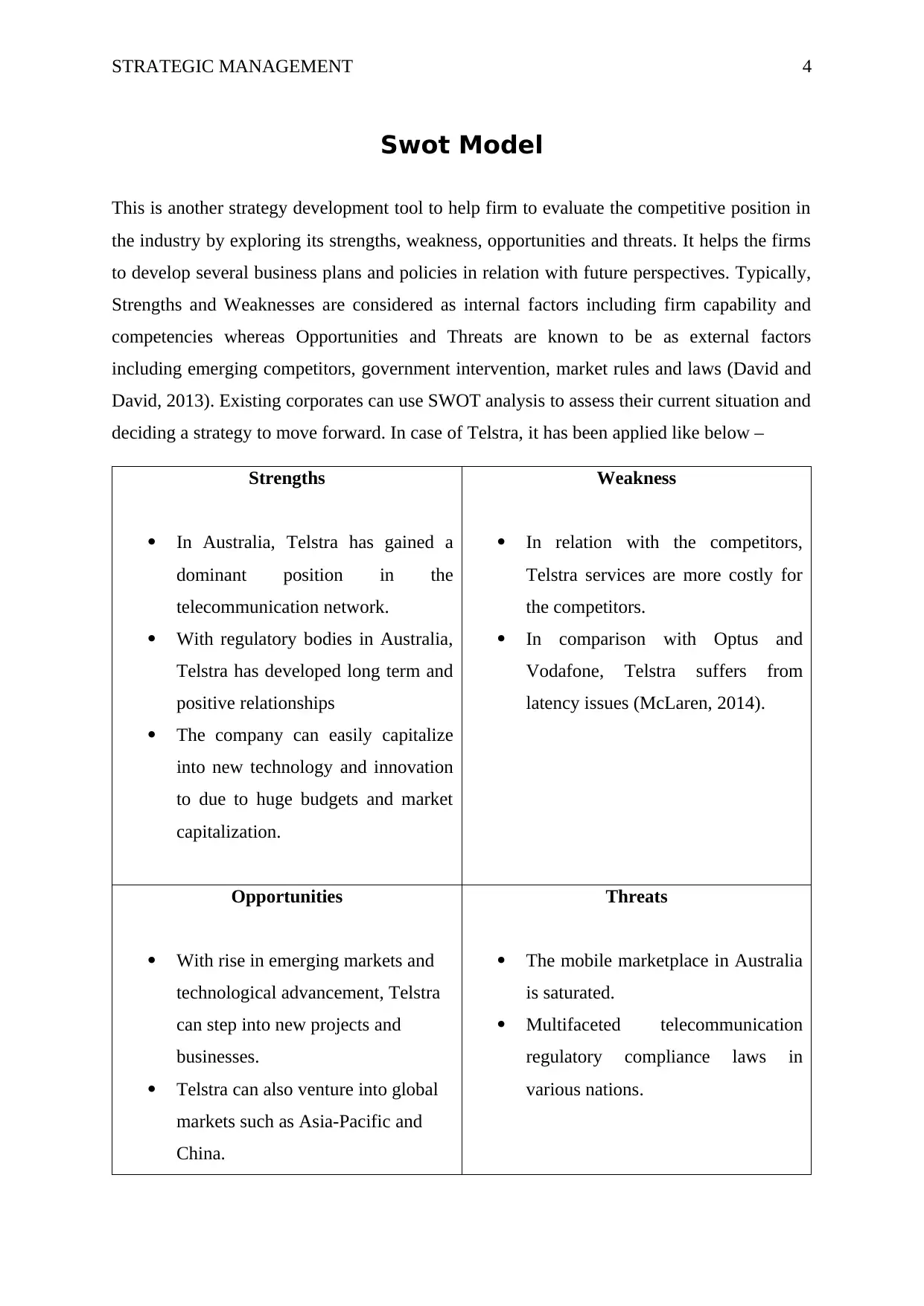
STRATEGIC MANAGEMENT 4
Swot Model
This is another strategy development tool to help firm to evaluate the competitive position in
the industry by exploring its strengths, weakness, opportunities and threats. It helps the firms
to develop several business plans and policies in relation with future perspectives. Typically,
Strengths and Weaknesses are considered as internal factors including firm capability and
competencies whereas Opportunities and Threats are known to be as external factors
including emerging competitors, government intervention, market rules and laws (David and
David, 2013). Existing corporates can use SWOT analysis to assess their current situation and
deciding a strategy to move forward. In case of Telstra, it has been applied like below –
Strengths
In Australia, Telstra has gained a
dominant position in the
telecommunication network.
With regulatory bodies in Australia,
Telstra has developed long term and
positive relationships
The company can easily capitalize
into new technology and innovation
to due to huge budgets and market
capitalization.
Weakness
In relation with the competitors,
Telstra services are more costly for
the competitors.
In comparison with Optus and
Vodafone, Telstra suffers from
latency issues (McLaren, 2014).
Opportunities
With rise in emerging markets and
technological advancement, Telstra
can step into new projects and
businesses.
Telstra can also venture into global
markets such as Asia-Pacific and
China.
Threats
The mobile marketplace in Australia
is saturated.
Multifaceted telecommunication
regulatory compliance laws in
various nations.
Swot Model
This is another strategy development tool to help firm to evaluate the competitive position in
the industry by exploring its strengths, weakness, opportunities and threats. It helps the firms
to develop several business plans and policies in relation with future perspectives. Typically,
Strengths and Weaknesses are considered as internal factors including firm capability and
competencies whereas Opportunities and Threats are known to be as external factors
including emerging competitors, government intervention, market rules and laws (David and
David, 2013). Existing corporates can use SWOT analysis to assess their current situation and
deciding a strategy to move forward. In case of Telstra, it has been applied like below –
Strengths
In Australia, Telstra has gained a
dominant position in the
telecommunication network.
With regulatory bodies in Australia,
Telstra has developed long term and
positive relationships
The company can easily capitalize
into new technology and innovation
to due to huge budgets and market
capitalization.
Weakness
In relation with the competitors,
Telstra services are more costly for
the competitors.
In comparison with Optus and
Vodafone, Telstra suffers from
latency issues (McLaren, 2014).
Opportunities
With rise in emerging markets and
technological advancement, Telstra
can step into new projects and
businesses.
Telstra can also venture into global
markets such as Asia-Pacific and
China.
Threats
The mobile marketplace in Australia
is saturated.
Multifaceted telecommunication
regulatory compliance laws in
various nations.
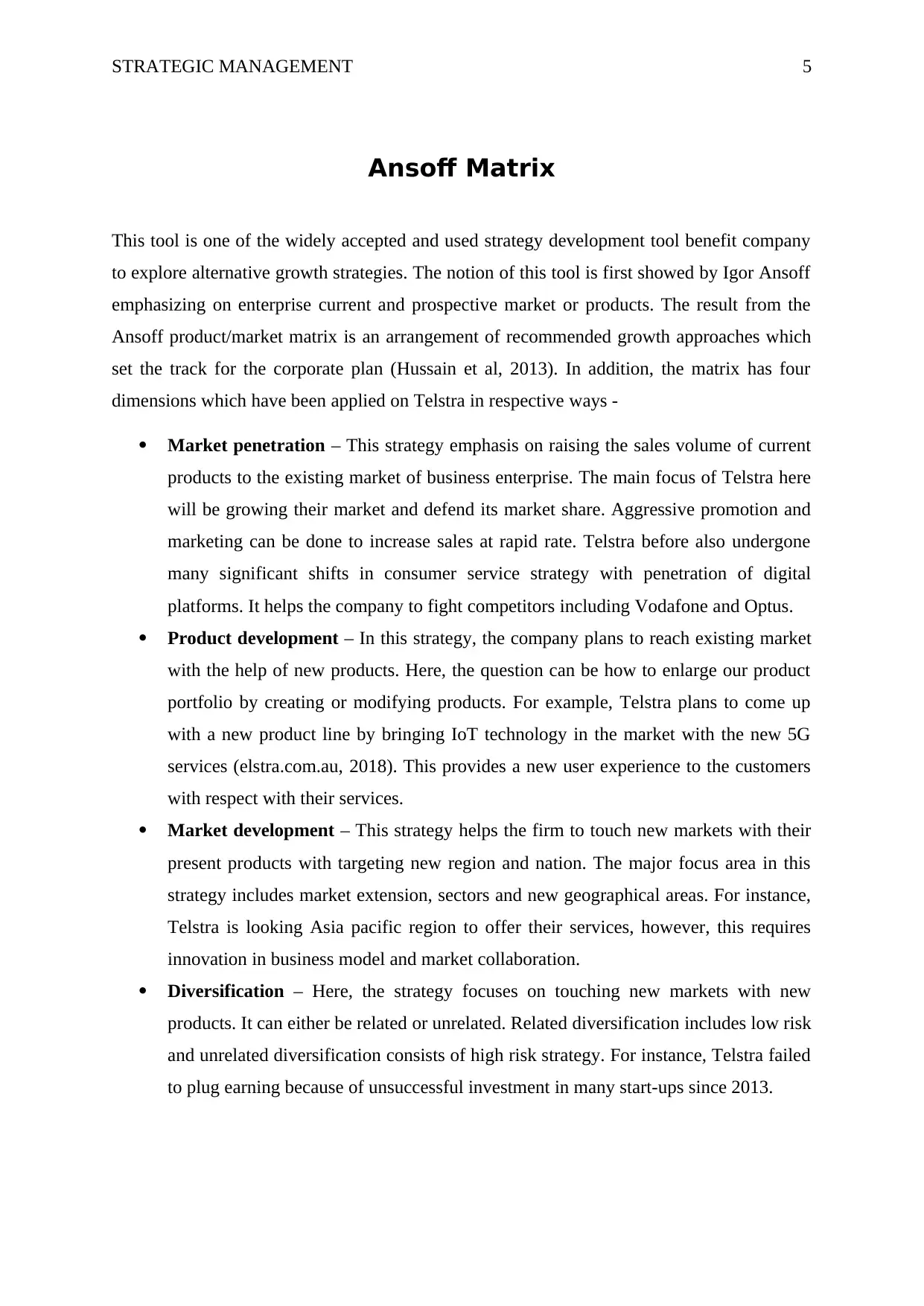
STRATEGIC MANAGEMENT 5
Ansoff Matrix
This tool is one of the widely accepted and used strategy development tool benefit company
to explore alternative growth strategies. The notion of this tool is first showed by Igor Ansoff
emphasizing on enterprise current and prospective market or products. The result from the
Ansoff product/market matrix is an arrangement of recommended growth approaches which
set the track for the corporate plan (Hussain et al, 2013). In addition, the matrix has four
dimensions which have been applied on Telstra in respective ways -
Market penetration – This strategy emphasis on raising the sales volume of current
products to the existing market of business enterprise. The main focus of Telstra here
will be growing their market and defend its market share. Aggressive promotion and
marketing can be done to increase sales at rapid rate. Telstra before also undergone
many significant shifts in consumer service strategy with penetration of digital
platforms. It helps the company to fight competitors including Vodafone and Optus.
Product development – In this strategy, the company plans to reach existing market
with the help of new products. Here, the question can be how to enlarge our product
portfolio by creating or modifying products. For example, Telstra plans to come up
with a new product line by bringing IoT technology in the market with the new 5G
services (elstra.com.au, 2018). This provides a new user experience to the customers
with respect with their services.
Market development – This strategy helps the firm to touch new markets with their
present products with targeting new region and nation. The major focus area in this
strategy includes market extension, sectors and new geographical areas. For instance,
Telstra is looking Asia pacific region to offer their services, however, this requires
innovation in business model and market collaboration.
Diversification – Here, the strategy focuses on touching new markets with new
products. It can either be related or unrelated. Related diversification includes low risk
and unrelated diversification consists of high risk strategy. For instance, Telstra failed
to plug earning because of unsuccessful investment in many start-ups since 2013.
Ansoff Matrix
This tool is one of the widely accepted and used strategy development tool benefit company
to explore alternative growth strategies. The notion of this tool is first showed by Igor Ansoff
emphasizing on enterprise current and prospective market or products. The result from the
Ansoff product/market matrix is an arrangement of recommended growth approaches which
set the track for the corporate plan (Hussain et al, 2013). In addition, the matrix has four
dimensions which have been applied on Telstra in respective ways -
Market penetration – This strategy emphasis on raising the sales volume of current
products to the existing market of business enterprise. The main focus of Telstra here
will be growing their market and defend its market share. Aggressive promotion and
marketing can be done to increase sales at rapid rate. Telstra before also undergone
many significant shifts in consumer service strategy with penetration of digital
platforms. It helps the company to fight competitors including Vodafone and Optus.
Product development – In this strategy, the company plans to reach existing market
with the help of new products. Here, the question can be how to enlarge our product
portfolio by creating or modifying products. For example, Telstra plans to come up
with a new product line by bringing IoT technology in the market with the new 5G
services (elstra.com.au, 2018). This provides a new user experience to the customers
with respect with their services.
Market development – This strategy helps the firm to touch new markets with their
present products with targeting new region and nation. The major focus area in this
strategy includes market extension, sectors and new geographical areas. For instance,
Telstra is looking Asia pacific region to offer their services, however, this requires
innovation in business model and market collaboration.
Diversification – Here, the strategy focuses on touching new markets with new
products. It can either be related or unrelated. Related diversification includes low risk
and unrelated diversification consists of high risk strategy. For instance, Telstra failed
to plug earning because of unsuccessful investment in many start-ups since 2013.
⊘ This is a preview!⊘
Do you want full access?
Subscribe today to unlock all pages.

Trusted by 1+ million students worldwide
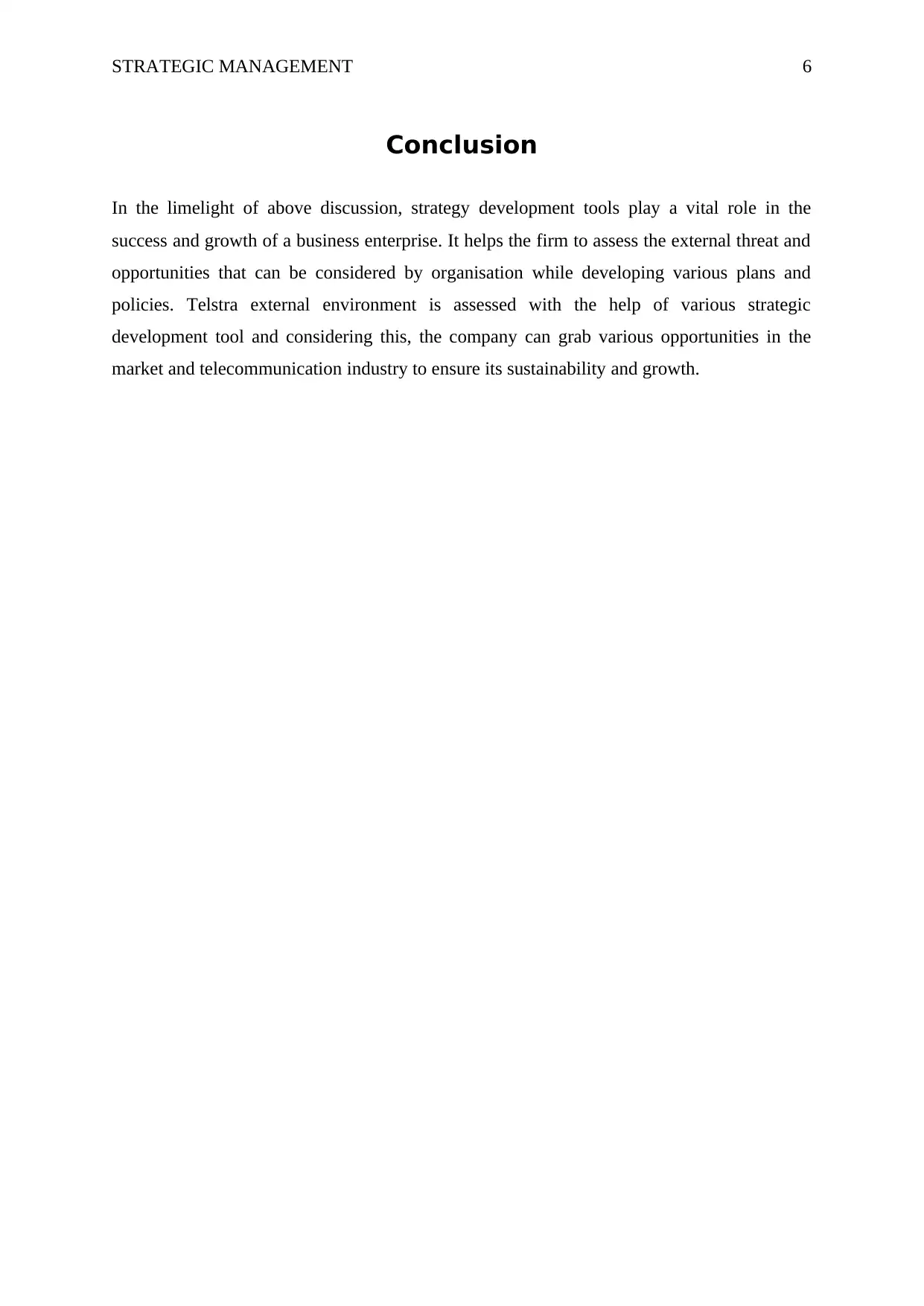
STRATEGIC MANAGEMENT 6
Conclusion
In the limelight of above discussion, strategy development tools play a vital role in the
success and growth of a business enterprise. It helps the firm to assess the external threat and
opportunities that can be considered by organisation while developing various plans and
policies. Telstra external environment is assessed with the help of various strategic
development tool and considering this, the company can grab various opportunities in the
market and telecommunication industry to ensure its sustainability and growth.
Conclusion
In the limelight of above discussion, strategy development tools play a vital role in the
success and growth of a business enterprise. It helps the firm to assess the external threat and
opportunities that can be considered by organisation while developing various plans and
policies. Telstra external environment is assessed with the help of various strategic
development tool and considering this, the company can grab various opportunities in the
market and telecommunication industry to ensure its sustainability and growth.
Paraphrase This Document
Need a fresh take? Get an instant paraphrase of this document with our AI Paraphraser
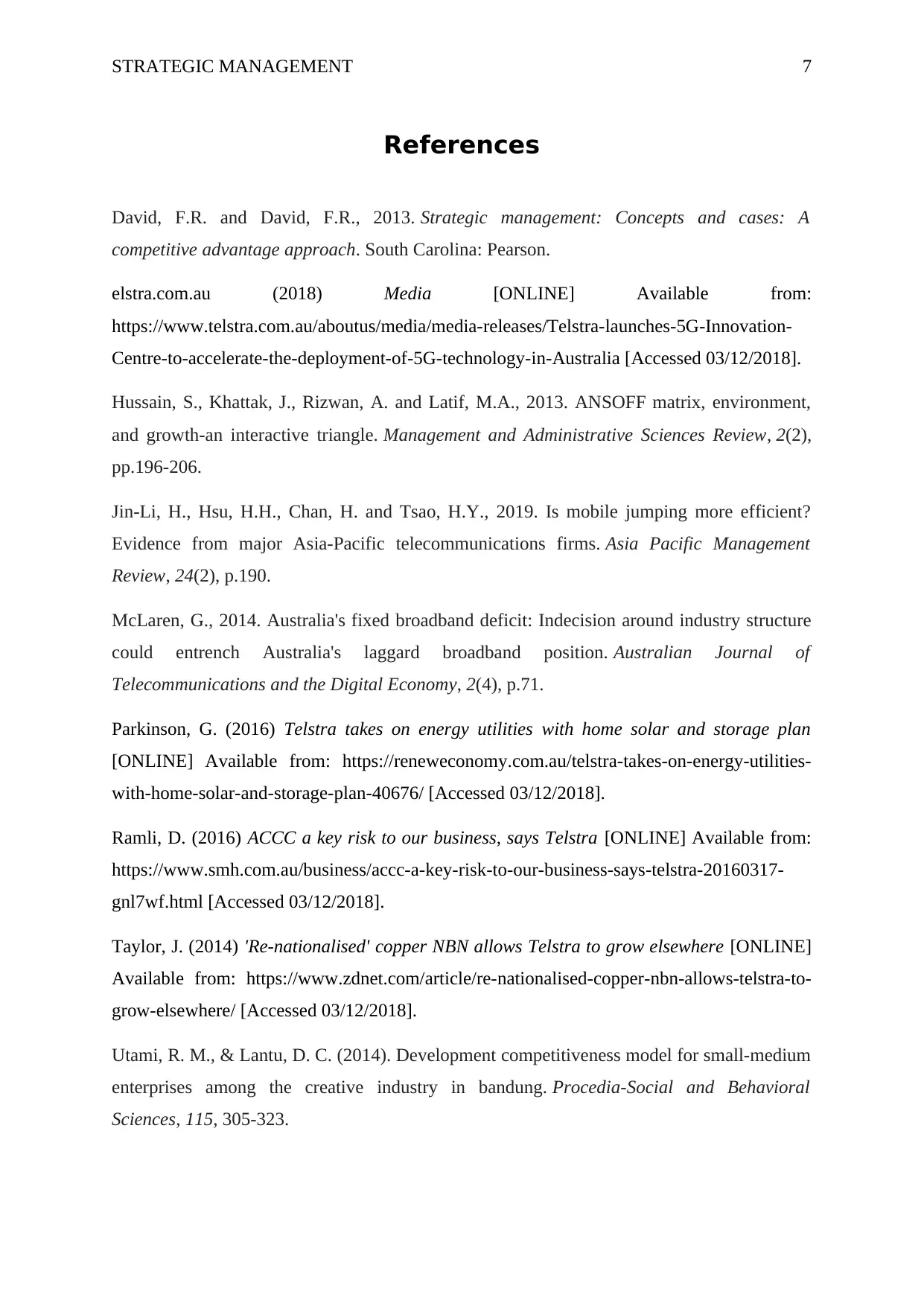
STRATEGIC MANAGEMENT 7
References
David, F.R. and David, F.R., 2013. Strategic management: Concepts and cases: A
competitive advantage approach. South Carolina: Pearson.
elstra.com.au (2018) Media [ONLINE] Available from:
https://www.telstra.com.au/aboutus/media/media-releases/Telstra-launches-5G-Innovation-
Centre-to-accelerate-the-deployment-of-5G-technology-in-Australia [Accessed 03/12/2018].
Hussain, S., Khattak, J., Rizwan, A. and Latif, M.A., 2013. ANSOFF matrix, environment,
and growth-an interactive triangle. Management and Administrative Sciences Review, 2(2),
pp.196-206.
Jin-Li, H., Hsu, H.H., Chan, H. and Tsao, H.Y., 2019. Is mobile jumping more efficient?
Evidence from major Asia-Pacific telecommunications firms. Asia Pacific Management
Review, 24(2), p.190.
McLaren, G., 2014. Australia's fixed broadband deficit: Indecision around industry structure
could entrench Australia's laggard broadband position. Australian Journal of
Telecommunications and the Digital Economy, 2(4), p.71.
Parkinson, G. (2016) Telstra takes on energy utilities with home solar and storage plan
[ONLINE] Available from: https://reneweconomy.com.au/telstra-takes-on-energy-utilities-
with-home-solar-and-storage-plan-40676/ [Accessed 03/12/2018].
Ramli, D. (2016) ACCC a key risk to our business, says Telstra [ONLINE] Available from:
https://www.smh.com.au/business/accc-a-key-risk-to-our-business-says-telstra-20160317-
gnl7wf.html [Accessed 03/12/2018].
Taylor, J. (2014) 'Re-nationalised' copper NBN allows Telstra to grow elsewhere [ONLINE]
Available from: https://www.zdnet.com/article/re-nationalised-copper-nbn-allows-telstra-to-
grow-elsewhere/ [Accessed 03/12/2018].
Utami, R. M., & Lantu, D. C. (2014). Development competitiveness model for small-medium
enterprises among the creative industry in bandung. Procedia-Social and Behavioral
Sciences, 115, 305-323.
References
David, F.R. and David, F.R., 2013. Strategic management: Concepts and cases: A
competitive advantage approach. South Carolina: Pearson.
elstra.com.au (2018) Media [ONLINE] Available from:
https://www.telstra.com.au/aboutus/media/media-releases/Telstra-launches-5G-Innovation-
Centre-to-accelerate-the-deployment-of-5G-technology-in-Australia [Accessed 03/12/2018].
Hussain, S., Khattak, J., Rizwan, A. and Latif, M.A., 2013. ANSOFF matrix, environment,
and growth-an interactive triangle. Management and Administrative Sciences Review, 2(2),
pp.196-206.
Jin-Li, H., Hsu, H.H., Chan, H. and Tsao, H.Y., 2019. Is mobile jumping more efficient?
Evidence from major Asia-Pacific telecommunications firms. Asia Pacific Management
Review, 24(2), p.190.
McLaren, G., 2014. Australia's fixed broadband deficit: Indecision around industry structure
could entrench Australia's laggard broadband position. Australian Journal of
Telecommunications and the Digital Economy, 2(4), p.71.
Parkinson, G. (2016) Telstra takes on energy utilities with home solar and storage plan
[ONLINE] Available from: https://reneweconomy.com.au/telstra-takes-on-energy-utilities-
with-home-solar-and-storage-plan-40676/ [Accessed 03/12/2018].
Ramli, D. (2016) ACCC a key risk to our business, says Telstra [ONLINE] Available from:
https://www.smh.com.au/business/accc-a-key-risk-to-our-business-says-telstra-20160317-
gnl7wf.html [Accessed 03/12/2018].
Taylor, J. (2014) 'Re-nationalised' copper NBN allows Telstra to grow elsewhere [ONLINE]
Available from: https://www.zdnet.com/article/re-nationalised-copper-nbn-allows-telstra-to-
grow-elsewhere/ [Accessed 03/12/2018].
Utami, R. M., & Lantu, D. C. (2014). Development competitiveness model for small-medium
enterprises among the creative industry in bandung. Procedia-Social and Behavioral
Sciences, 115, 305-323.
1 out of 8
Related Documents
Your All-in-One AI-Powered Toolkit for Academic Success.
+13062052269
info@desklib.com
Available 24*7 on WhatsApp / Email
![[object Object]](/_next/static/media/star-bottom.7253800d.svg)
Unlock your academic potential
Copyright © 2020–2025 A2Z Services. All Rights Reserved. Developed and managed by ZUCOL.



